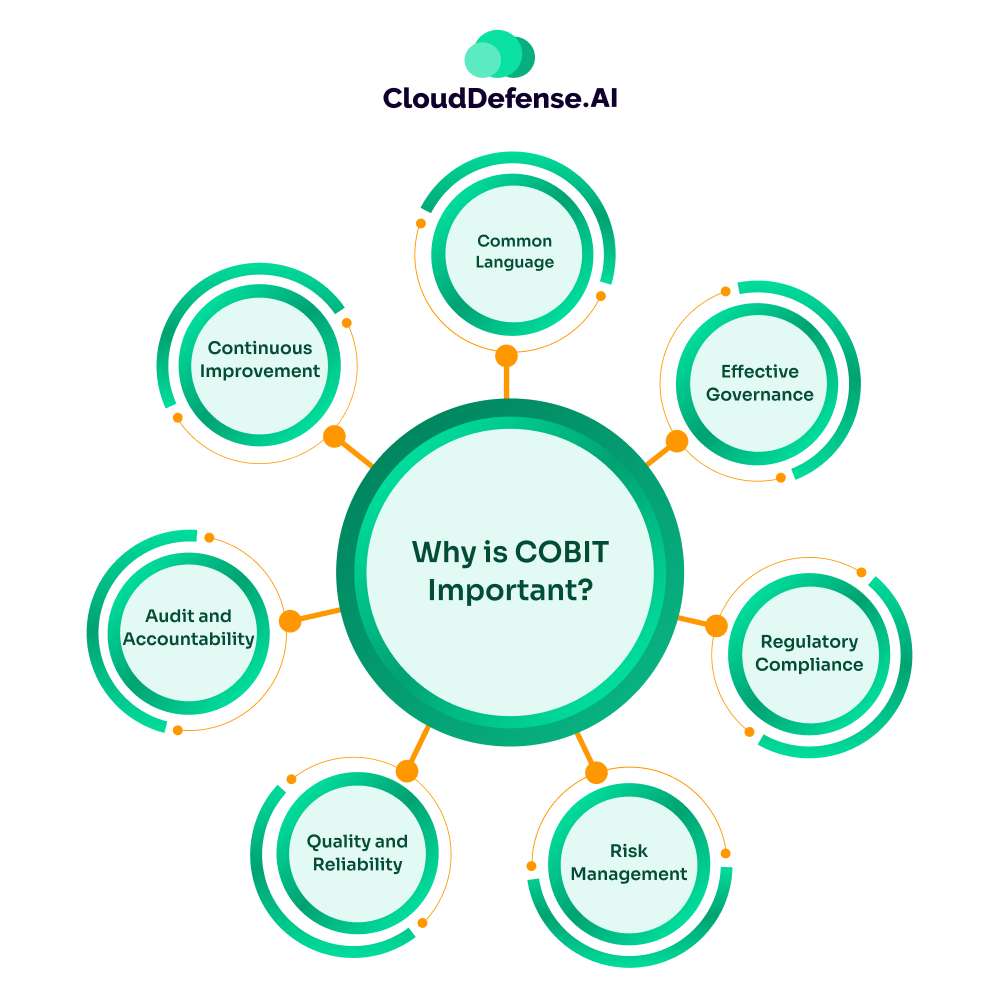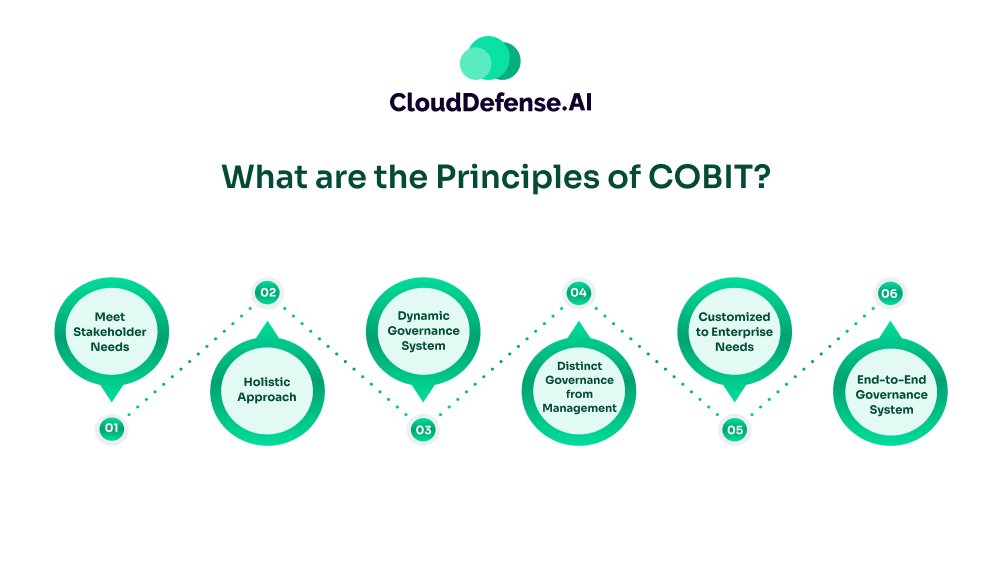What is COBIT?
COBIT, or Control Objectives for Information and Related Technology, is a comprehensive framework designed to guide the development, implementation, improvement, and management of information technology systems.
Published by the Information Technology Governance Institute, a branch of the Information Systems Audit and Control Association, or ISACA, COBIT aims to ensure that IT aligns with an organization’s business objectives and provides value while minimizing risks.
First introduced in 1996, COBIT has evolved to become a pivotal tool in IT governance. It assists organizations in establishing clear policies and procedures. It helps manage and control IT processes, ensuring they are efficient, effective, and compliant with regulatory requirements.
In the United States, COBIT has been particularly significant in aiding organizations in adhering to the compliance standards set forth by the Sarbanes-Oxley Act of 2002. Through its structured approach, COBIT provides a framework for achieving strategic goals, optimizing resource utilization, and effectively managing risks in the realm of information technology.
What is ISACA?
ISACA, or Information Systems Audit and Control Association, is a global professional association focused on IT governance, risk management, and cybersecurity. Founded in 1969, ISACA provides members with knowledge, credentials, education, and community to enhance their skills and careers.
It is known for establishing industry standards, such as the COBIT framework for IT governance and management, and offers globally recognized certifications, including CISA and Certified Information Security Manager. ISACA serves IT professionals, auditors, and business leaders, promoting best practices and providing resources to manage and secure information systems effectively.
Why is COBIT Important?

COBIT is needed for several reasons, making it an essential framework for organizations across various industries. Here’s why COBIT is important:
1. Common Language
COBIT provides a unified language for IT professionals, compliance auditors, and business executives. This common language ensures clear communication regarding IT goals, controls, objectives, and outcomes, reducing misunderstandings and streamlining collaboration across different departments.
2. Effective Governance
The framework enables organizations to develop, implement, improve, and manage their IT systems effectively. It ensures that IT aligns with business objectives, contributing to overall strategic goals and optimizing resource utilization.
3. Regulatory Compliance
COBIT is instrumental in helping organizations meet regulatory requirements. For instance, in the United States, it supports compliance with the Sarbanes-Oxley (SOX) Act of 2002. This compliance is critical for maintaining legal standards and avoiding penalties.
4. Risk Management
By implementing COBIT, organizations can identify, assess, and manage IT risks more effectively. The framework provides guidelines for establishing controls that mitigate risks and enhance the security and reliability of IT systems.
5. Quality and Reliability
COBIT ensures high control, quality, and reliability of IT systems. It helps organizations establish robust processes and practices that enhance system performance and reliability, leading to better service delivery and customer satisfaction.
6. Audit and Accountability
The framework facilitates easier auditing and accountability by providing clear documentation and standards for IT processes. This transparency makes it simpler to track compliance and performance, ensuring that IT systems adhere to established policies and standards.
7. Continuous Improvement
COBIT promotes a culture of continuous improvement in IT governance and management. By following its guidelines, organizations can regularly assess and enhance their IT processes, adapting to new challenges and technological advancements.
What is COBIT 2019?
COBIT 2019 is the latest version of the COBIT framework. COBIT 2019 helps organizations ensure that their IT systems are aligned with business goals, deliver value, and mitigate risks effectively. The framework integrates best practices and principles for managing information and technology to support enterprise objectives.
Key features of COBIT 2019 include:
- Updated Framework: COBIT 2019 incorporates the latest advancements and changes in technology and business environments, making it relevant for contemporary IT governance challenges.
- Six Governance Principles: The framework is built on six core principles:
- Meet Stakeholder Needs
- Holistic Approach
- Dynamic Governance System
- Distinct Governance from Management
- Customized to Enterprise Needs
- End-to-End Governance System
- Performance Management: COBIT 2019 includes a performance management system that allows organizations to measure and manage their governance and management objectives effectively.
- Design Factors: The framework provides guidance on design factors, enabling organizations to tailor the COBIT framework to their specific needs and contexts, considering factors like enterprise strategy, goals, risk profile, and regulatory requirements.
- Governance and Management Objectives: COBIT 2019 outlines a set of governance and management objectives that cover various aspects of IT and business integration, providing a structured way to achieve alignment and performance goals.
- Implementation Guidance: The framework offers detailed guidance on implementing and maintaining an effective governance system, including practical steps, best practices, and tools.
What are the Principles of COBIT?

COBIT 2019 introduces six fundamental principles designed to guide the establishment of a robust governance system for IT. These principles ensure that IT governance is aligned with business goals, adaptive to changing environments, and tailored to specific organizational needs. Here’s an overview of these principles:
1. Meet Stakeholder Needs
COBIT 2019 emphasizes that the primary goal of IT governance is to create value for stakeholders. This principle ensures that the governance system aligns IT initiatives with stakeholder expectations, addressing their needs and delivering benefits while balancing risks and resources.
2. Holistic Approach
This principle advocates for a comprehensive view of IT governance, integrating various components such as processes, structures, and information flows. By considering the inter-dependencies within the organization, a holistic approach ensures that all aspects of IT governance work cohesively to support business objectives.
3. Dynamic Governance System
The dynamic nature of business environments requires a flexible governance system. COBIT 2019 recognizes the need for adaptability, allowing governance frameworks to evolve in response to new challenges, technological advancements, and changing business landscapes. This principle ensures that governance remains relevant and effective over time.
4. Distinct Governance from Management
COBIT 2019 clearly delineates governance from management. Governance involves setting objectives, monitoring performance, and ensuring accountability, while management focuses on planning, building, running, and monitoring activities to achieve those objectives. This separation ensures clarity in roles and responsibilities, leading to more effective oversight and execution.
5. Customized to Enterprise Needs:
Every organization is unique, and COBIT 2019 recognizes the importance of tailoring the governance system to fit specific enterprise needs. This principle promotes customization based on the organization’s size, industry, regulatory environment, and strategic goals, ensuring that the governance framework is relevant and effective.
6. End-to-End Governance System
The end-to-end principle ensures that governance encompasses the entire organization, not just the IT department. It integrates governance practices across all levels and functions, ensuring comprehensive oversight and control over all IT-related activities. This holistic governance approach enhances alignment with overall business strategies and objectives.
These six principles of COBIT 2019 provide a structured and flexible framework for IT governance, enabling organizations to align their IT initiatives with business goals, adapt to changes, and achieve optimal performance and compliance.
How does COBIT compare with other Governance Frameworks?
COBIT stands out among governance frameworks due to its broad focus on IT governance and risk management, contrasting sharply with frameworks like ITIL and TOGAF in terms of scope and application.
COBIT vs. ITIL
The ITIL framework is primarily concerned with IT Service Management, aiming to align IT services with the needs of the business. ITIL’s narrow focus on IT service delivery and management makes it highly specialized for optimizing IT service processes. In contrast, COBIT offers a wider lens, encompassing comprehensive risk management that can be applied across various business areas beyond IT services.
Another key difference is in the approach to compliance and auditing. ITIL often requires third-party tools like the Tudor IT Process Assessment to document compliance. Conversely, COBIT audits are typically conducted by ISACA Certified Information Systems Auditors, providing a more integrated and standardized auditing process.
COBIT vs. TOGAF
TOGAF, or The Open Group Architecture Framework, is an architectural framework used for designing, planning, implementing, and governing an enterprise information architecture. While COBIT focuses on creating an enterprise-wide IT governance system with multiple security controls, TOGAF is dedicated to developing an information architecture that aligns business and IT goals. TOGAF’s emphasis is on integrating and streamlining business processes through well-defined architectures.
COBIT’s broader approach to IT governance makes it ideal for organizations looking to implement extensive control and risk management systems. In contrast, TOGAF is best suited for organizations seeking to develop robust IT architecture frameworks that align closely with their business strategies.
Despite their differences, COBIT and TOGAF can be used together as a hybrid model to establish a comprehensive governance framework that leverages the strengths of both governance and architectural methodologies.
Hybrid Use and Comprehensive Governance
Combining COBIT with other frameworks like ITIL and TOGAF can yield a powerful governance model that ensures comprehensive oversight and alignment of IT services with business objectives. By integrating COBIT’s robust risk management and governance controls with ITIL’s specialized IT service management and TOGAF’s architectural alignment, organizations can create a cohesive and efficient governance structure.
This hybrid approach allows businesses to benefit from the specific strengths of each framework, ensuring that their IT systems are well-governed, aligned with business goals, and optimized for performance and security.
Benefits of COBIT

The COBIT framework offers a multitude of benefits that span across various roles within an organization, ensuring that IT governance and management are aligned with business objectives and stakeholder needs. Here’s a comprehensive look at the benefits of implementing the COBIT framework:
1. Meeting Stakeholder Needs
One of the primary benefits of employing the COBIT framework is its ability to address the needs of all stakeholders, including end-users. By integrating a unified governance system, COBIT ensures that the requirements and expectations of stakeholders are met efficiently, enhancing overall satisfaction and engagement.
2. Comprehensive Enterprise Architecture Protection
COBIT guides and protects the entire enterprise architecture, encompassing all network elements and end-user devices. This holistic approach to IT governance helps in identifying and mitigating risks across the entire IT landscape, ensuring robust protection and continuity.
3. Holistic IT Management
COBIT promotes a holistic approach to tackling IT challenges by integrating various IT processes and frameworks into one cohesive system. This unified approach ensures that all IT functions work seamlessly together, improving efficiency and reducing the potential for conflicting processes.
4. Clear Segmentation of Governance and Management
One of COBIT’s standout features is its clear distinction between governance and management. This separation allows for an objective assessment of IT system performance, ensuring unbiased evaluations and more effective governance practices.
5. Benefits for CIOs, IT Managers, and IT Directors
For CIOs, IT managers, and IT directors, COBIT offers a streamlined set of strategies for solution design, communication, and maintenance. This unified approach simplifies IT management and enhances strategic decision-making, leading to more efficient and effective IT operations.
6. Advantages for Risk Committees
Risk committees benefit significantly from COBIT’s comprehensive framework. By managing all solutions under a single umbrella, COBIT reduces the likelihood of vulnerabilities being overlooked, thereby strengthening the organization’s overall risk management posture.
7. Support for Process Owners
Process owners tasked with developing and maintaining IT processes benefit from COBIT’s holistic development environment. This ensures that individual processes are not created in isolation but are designed to work harmoniously, enhancing the efficiency and effectiveness of IT operations.
8. Simplified Auditing for Audit Committees
COBIT simplifies the work of audit committees by providing a unified framework for all IT governance activities. With everyone operating from the same playbook, deviations from standards are easier to identify and rectify, leading to more efficient and accurate audits.
9. Empowering IT Professionals in Audit, Risk, Security, Governance, and Assurance
IT professionals working in audit, risk, security, governance, and assurance sectors gain from COBIT’s detailed and step-by-step framework. Additionally, obtaining COBIT certification provides these professionals with a marketable skill set, enhancing their career prospects and demonstrating their expertise in IT governance.
Final Words
The COBIT framework stands as a cornerstone for effective IT governance and management, bridging the gap between IT and business objectives. By meeting stakeholder needs, ensuring comprehensive protection of enterprise architecture, and building a holistic approach to IT challenges, COBIT empowers organizations to achieve strategic goals with confidence.
Its clear segmentation of governance and management enhances objectivity and efficiency, benefiting CIOs, risk committees, process owners, and IT professionals alike. Embracing COBIT strengthens IT governance and ensures an organization remains resilient, compliant, and competitive.







